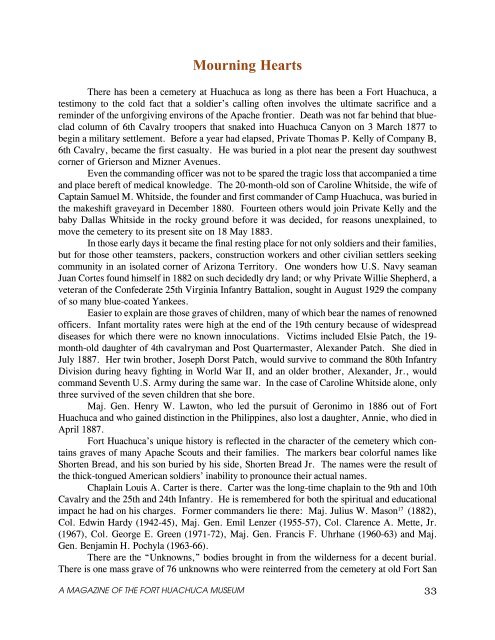Apache Campaigns - Fort Huachuca - U.S. Army
Apache Campaigns - Fort Huachuca - U.S. Army
Apache Campaigns - Fort Huachuca - U.S. Army
You also want an ePaper? Increase the reach of your titles
YUMPU automatically turns print PDFs into web optimized ePapers that Google loves.
A MAGAZINE OF THE FORT HUACHUCA MUSEUM<br />
Mourning Hearts<br />
There has been a cemetery at <strong>Huachuca</strong> as long as there has been a <strong>Fort</strong> <strong>Huachuca</strong>, a<br />
testimony to the cold fact that a soldier’s calling often involves the ultimate sacrifice and a<br />
reminder of the unforgiving environs of the <strong>Apache</strong> frontier. Death was not far behind that blueclad<br />
column of 6th Cavalry troopers that snaked into <strong>Huachuca</strong> Canyon on 3 March 1877 to<br />
begin a military settlement. Before a year had elapsed, Private Thomas P. Kelly of Company B,<br />
6th Cavalry, became the first casualty. He was buried in a plot near the present day southwest<br />
corner of Grierson and Mizner Avenues.<br />
Even the commanding officer was not to be spared the tragic loss that accompanied a time<br />
and place bereft of medical knowledge. The 20-month-old son of Caroline Whitside, the wife of<br />
Captain Samuel M. Whitside, the founder and first commander of Camp <strong>Huachuca</strong>, was buried in<br />
the makeshift graveyard in December 1880. Fourteen others would join Private Kelly and the<br />
baby Dallas Whitside in the rocky ground before it was decided, for reasons unexplained, to<br />
move the cemetery to its present site on 18 May 1883.<br />
In those early days it became the final resting place for not only soldiers and their families,<br />
but for those other teamsters, packers, construction workers and other civilian settlers seeking<br />
community in an isolated corner of Arizona Territory. One wonders how U.S. Navy seaman<br />
Juan Cortes found himself in 1882 on such decidedly dry land; or why Private Willie Shepherd, a<br />
veteran of the Confederate 25th Virginia Infantry Battalion, sought in August 1929 the company<br />
of so many blue-coated Yankees.<br />
Easier to explain are those graves of children, many of which bear the names of renowned<br />
officers. Infant mortality rates were high at the end of the 19th century because of widespread<br />
diseases for which there were no known innoculations. Victims included Elsie Patch, the 19month-old<br />
daughter of 4th cavalryman and Post Quartermaster, Alexander Patch. She died in<br />
July 1887. Her twin brother, Joseph Dorst Patch, would survive to command the 80th Infantry<br />
Division during heavy fighting in World War II, and an older brother, Alexander, Jr., would<br />
command Seventh U.S. <strong>Army</strong> during the same war. In the case of Caroline Whitside alone, only<br />
three survived of the seven children that she bore.<br />
Maj. Gen. Henry W. Lawton, who led the pursuit of Geronimo in 1886 out of <strong>Fort</strong><br />
<strong>Huachuca</strong> and who gained distinction in the Philippines, also lost a daughter, Annie, who died in<br />
April 1887.<br />
<strong>Fort</strong> <strong>Huachuca</strong>’s unique history is reflected in the character of the cemetery which contains<br />
graves of many <strong>Apache</strong> Scouts and their families. The markers bear colorful names like<br />
Shorten Bread, and his son buried by his side, Shorten Bread Jr. The names were the result of<br />
the thick-tongued American soldiers’ inability to pronounce their actual names.<br />
Chaplain Louis A. Carter is there. Carter was the long-time chaplain to the 9th and 10th<br />
Cavalry and the 25th and 24th Infantry. He is remembered for both the spiritual and educational<br />
impact he had on his charges. Former commanders lie there: Maj. Julius W. Mason 17 (1882),<br />
Col. Edwin Hardy (1942-45), Maj. Gen. Emil Lenzer (1955-57), Col. Clarence A. Mette, Jr.<br />
(1967), Col. George E. Green (1971-72), Maj. Gen. Francis F. Uhrhane (1960-63) and Maj.<br />
Gen. Benjamin H. Pochyla (1963-66).<br />
There are the “Unknowns,” bodies brought in from the wilderness for a decent burial.<br />
There is one mass grave of 76 unknowns who were reinterred from the cemetery at old <strong>Fort</strong> San<br />
33

















